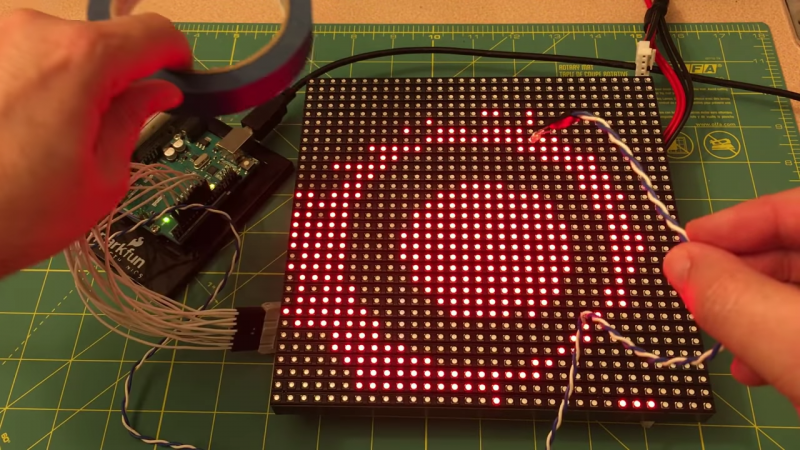A digital camera has an array of sensors that captures light reflected or transmitted onto it. This build is something closer to a reverse camera – a single sensor that makes images on a matrix of LEDs. And we think it’s pretty neat.
We have to admit to being a little confused by [marciot]’s LED matrix scanner when we first stumbled upon it. From the video below we thought that the LEDs in the matrix were being used both to detect incident light and as a display. We’ve seen LEDs used as photodiodes before, so such a contraption could work, but that’s not what’s going on here. A phototransistor is wired to an Arduino Uno and positioned above a 32×32 RGB LED matrix. A scanning routine rasters over the LEDs in the matrix while the sensor watches, and then the program turns on the LEDs that the sensor saw during the scan. Positioned far above the matrix, a large disc of light results, making it look like the phototransistor is beaming light down onto the matrix. The effect is reinforced by placing something between the sensor and the matrix, which casts a virtual shadow. Used close to the LEDs the sensor acts more like a light pen.
It’s a cool effect and it looks like a fun project to throw together. Refresh time could perhaps be a bit snappier, though; maybe an ESP32 could help with that.
[via Arduino Blog]
















Cool project. I *highly* *highly* recommend you read more into the subject of compressed sensing. Instead of raster scanning pixel by pixel, you can scan in another basis, e.g. discrete cosine transform (DCT) basis or wavelet basis. Basically you turn on groups of LEDs at a time instead of a single LED. In some sense, instead of reverse imaging a bitmap, you are reverse imaging a JPEG and you can produce an image much faster, with the assumption that your object being imaged is a fairly normal real-world object, which it usually is.
That sounds interesting, do you have some more info (link suggestions) about that?
maybe they could integrate this into an lcd or oled screen to make a touchscreen. Even thinner displays.
Replace the matrix with a projector and use 4 sensors and you get this: https://www.youtube.com/watch?v=XgrGjJUBF_I
Nice! I’ll have to do this for my next project! I have a projector at home to play with.
That’s smart, and relatively fast, with outstanding results.
Thanks for these, I was actually watching some concert and I was curious how they were projecting images(accurately) in non-plain surface for additional effects on the stage.
Cool… Just like the old flying spot scanners for film but with an LED matrix instead of a CRT.
Make it a wall! (Need some more LEDs though.)
Lots of old-school CRT sensors worked like this, such as the NES Duck Hunt gun.
I think the idea of detecting with the LED matrix is interesting. Assuming they’re RGB LEDs, you could even pick up a different coloured ‘pen’ and detect and display the corresponding colour with some difference sensing.
my personal thought of this is an excellent way to test blind spots of the phototransister. as well as their color sensitivity really quickly. this would have saved me a large amount of time figuring out a transisters burned out spots